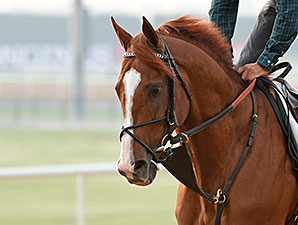American Trainers Approve Meydan Move to Dirt

The decision to replace the all-weather Tapeta Footings surface at Meydan with dirt has had an impact on the 2015 Dubai World Cup races, not least in the regeneration of interest among American trainers.
After dominating the marquee Dubai World Cup (UAE-I) over the old Nad al Sheba dirt track, American interest waned when Meydan opened in 2010 with the rich brown Tapeta oval inside its grass course. The exception, of course, was Animal Kingdom , who was a proven commodity on the all-weather surface at home. Other than that, not much. And the Americans who did show up on World Cup night didn't fare very well.
Perhaps the nadir of U.S. participation was Royal Delta's dismal showing over the Tapeta in the World Cup. The imposing mare, dominant back home, could do no better than ninth in the 2012 World Cup and 10th the following year. Her trainer, Bill Mott, had saddled Cigar to victory in the inaugural running of the World Cup in 1996, helping Sheikh Mohammed bin Rashid al Maktoum establish his ambitious event as an event worthy of the world's notice.
Mott is back this year with Lea, who comes from Gulfstream Park in good form after a narrow loss to Constitution in the Donn Handicap (gr. I) in his second start back from a long layoff.
"We are certainly here because the race is back on dirt and our horse has done his best running on the dirt," Mott said at midweek before the World Cup card, set for March 28. "Just from what I can tell from looking at the surface ... it looks very good. I walked across it and it looks like our horse handles it well, which is the most important thing."
The same is true for California Chrome's connections. The reigning U.S. Horse of the Year has won on dirt, turf, and the old Hollywood Park synthetic. But trainer Art Sherman said it's unlikely he would have shipped from California to Dubai to run on Tapeta.
"I don't know if we'd have come if it were still the old track," Sherman said. "He likes a firm dirt track and to hear his feet rattle a little."
Even some of the locals are happy to see the return of dirt. Doug Watson, who has been in Dubai since 1993 and trains for Sheikh Hamdan, said his horses have struggled since the action shifted from Nad al Sheba to Meydan. And he has a theory about why that happened.
"We didn't train on it," Watson said. "We have our own training center over in Al Quoz. I think that was a bit of a hindrance. I think the horses use different muscles and push off differently and land differently, so I don't think we ever came over here and ran particularly well on it. I know we'd have horses at home that we thought were just flying and we'd come over here and run eighth, ninth, 10th, whatever it was, and then this year, even through the first three or four meets, we were having some success ... The horses held the form that I thought we had.
"We had some nice seasons before the Tapeta went down," he reflected. "You pretty much lost a little bit of confidence as a trainer over the last five years."
In this year's World Cup, Watson saddles Candy Boy, whose previous experience was all on the American dirt.
Others took a little longer to appreciate the new track. South African conditioner Mike de Kock, long a force in Dubai, protested vehemently after the opening night of the World Cup Carnival that the track was too sandy and unsuitable for his horses. He said he would stay in the barn rather than run on the new track.
After a few more successful outings, however, de Kock's position apparently mellowed. He has runners on World Cup night in both the UAE Derby (UAE-II) and the Godolphin Mile (UAE-II).
There also were some raised eyebrows when Godolphin Racing's 2014 Dubai World Cup winner African Story finished a dismal seventh in his first effort over the new track in the Al Maktoum Challenge Round 2 (UAE-II). But he came back to win Round 3 (UAE-I) and jockey James Doyle said the initial flop was due not to sand but to rust.
"He hadn't run since the World Cup last year, so he was entitled to be a bit ring rusty," Doyle told Gulf News.
